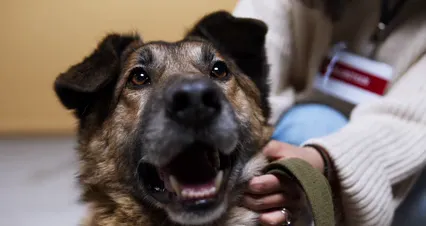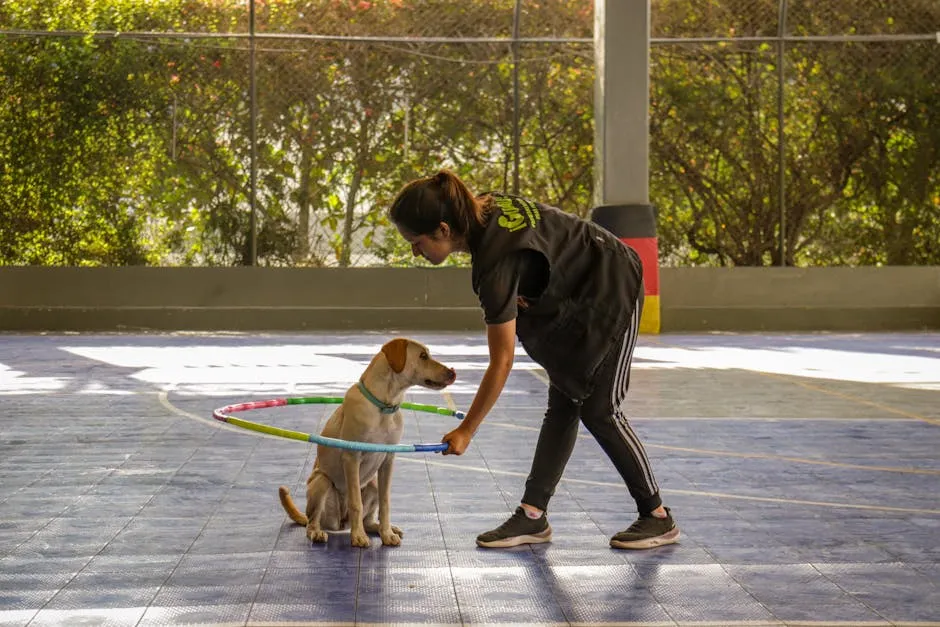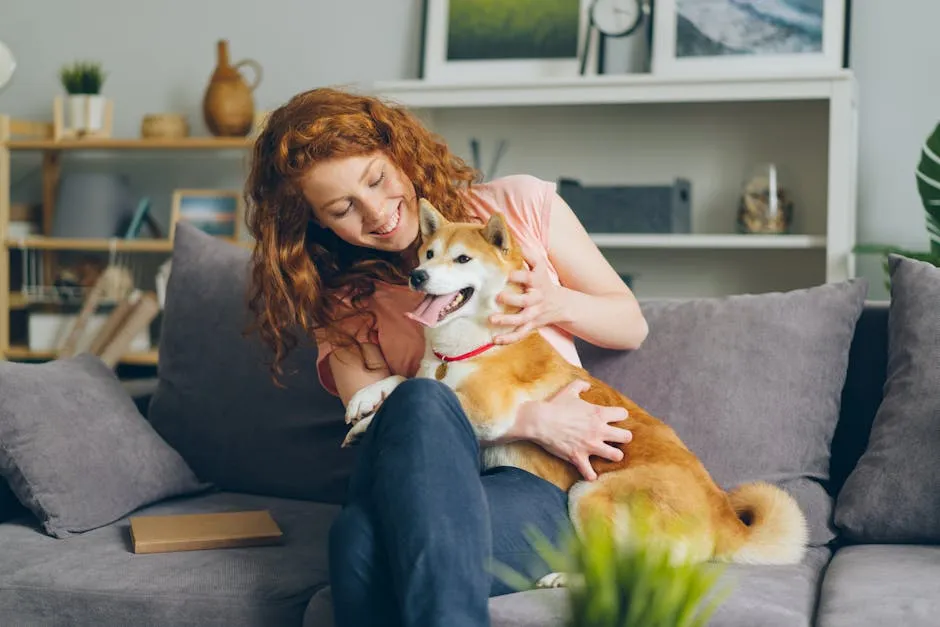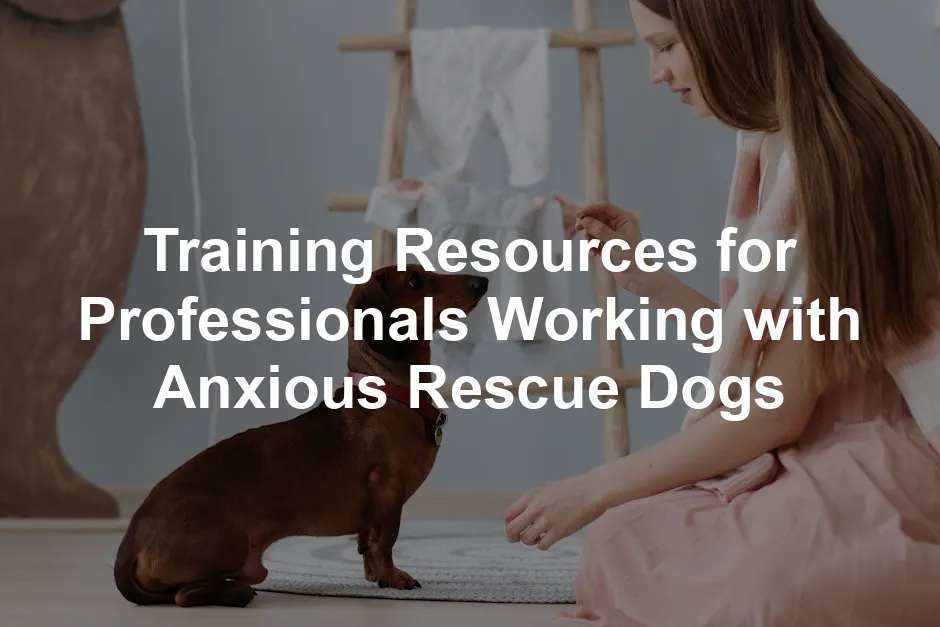Introduction
Navigating the world of anxious rescue dogs can feel like trying to solve a Rubik’s Cube blindfolded – challenging, yet rewarding once you crack the code. These dogs, often burdened with past traumas, demand specialized training techniques that cater to their unique needs. Whether you’re a seasoned trainer or a newbie volunteer at a shelter, understanding the intricacies of training anxious rescue dogs is essential.
Imagine a pup shaking in the corner, unsure of their surroundings. They need a gentle guide to help them through their fears. Here, we’ll provide a treasure trove of resources and strategies that can help you build a bridge of trust between yourself and these sensitive souls.
Positive reinforcement is the name of the game. Techniques like desensitization and counter-conditioning can turn anxiety into confidence. With the right approach, you can create a safer, happier world for our four-legged friends! For more on this, check out our article on effective positive reinforcement techniques for stubborn dogs.
If you’re looking for more structured guidance, consider picking up The Cautious Canine by Patricia McConnell. This book provides practical advice for helping dogs overcome their fears through structured training, making it a must-read for anyone working with anxious pups!
Understanding positive reinforcement can significantly enhance your training methods. Learn more about effective positive reinforcement techniques for stubborn dogs.
From insightful articles to hands-on workshops, the resources available can empower you to make a real difference. In this comprehensive guide, we’ll explore various training methodologies and community resources designed specifically for professionals working with anxious dogs. Get ready to transform anxiety into confidence and help these dogs find their happy place!

Summary of Key Points
In this blog post, we explore the various training resources available for professionals working with anxious rescue dogs, highlighting the importance of positive reinforcement techniques. The article covers:
- Understanding Anxious Behavior: Insights into the common anxieties and fears of rescue dogs, including separation anxiety and fear-based aggression.
- Effective Training Techniques: A breakdown of successful methods such as desensitization, counter-conditioning, and positive reinforcement.
- Resource Recommendations: A curated list of websites, books, webinars, and courses tailored specifically for trainers and behaviorists working with anxious dogs.
- Professional Support: The significance of collaborating with certified trainers and behaviorists to ensure the best outcomes for anxious dogs.
- Community Resources: Information on local organizations that offer support, workshops, and training opportunities for professionals.
By exploring these areas, this post aims to equip trainers with the tools they need to make a meaningful impact on the lives of anxious rescue dogs. One of the key issues addressed is separation anxiety, which can be particularly challenging. For more information on this topic, see our post on understanding and treating canine separation anxiety.
Understanding separation anxiety is crucial for effectively helping anxious dogs. Explore more about understanding and treating canine separation anxiety.
Understanding Anxious Behavior
Common Anxieties in Rescue Dogs
Anxious rescue dogs often come with a suitcase full of fears. Let’s unpack that luggage! Among the most common anxieties are separation anxiety, fear of strangers, and fear of loud noises.
Separation anxiety is like that clingy friend who believes you’ll never return. When you leave, your pup may howl, chew, or even try to escape. It’s a real heartbreaker for both of you.
Fear of strangers can turn a sweet dog into a mini Sasquatch. They might bark, hide, or freeze up when meeting new people. This is often a result of past trauma or lack of socialization.
And let’s not forget fear of loud noises. Thunderstorms, fireworks, or even the vacuum cleaner can send your furry friend into a tailspin. These noises can trigger panic, leading to destructive behavior.
So, how do you spot anxiety in your rescue dog? Look for signs like excessive barking, trembling, hiding, or destructive behavior. If your pup is acting like a drama queen, they might need a little extra love and attention.
For a more hands-on approach to calming your anxious pup, consider investing in a Dog Anxiety Wrap – ThunderShirt. This handy tool applies gentle pressure, providing a calming effect for anxious dogs, especially during stressful situations like thunderstorms or fireworks.
Understanding the Impact of Trauma
Past experiences can leave deep emotional scars on rescue dogs. Abuse, neglect, or even just being in a shelter can profoundly influence their behavior. Dogs are sensitive creatures and often carry the weight of their past with them.
This is where patience and empathy become your best friends. Understanding that your dog may react out of fear is crucial. Each time your pup flinches, it’s not just a reflex; it’s a response to something they’ve endured.
Building trust takes time. Consistent, gentle training helps create a safe environment. Offer plenty of reassurance, and don’t rush the process. Celebrate small victories, like a wagging tail or a nose boop.
With your patience and empathy, you can help your dog navigate their feelings and emerge stronger. Remember, every moment of kindness counts. It’s a journey worth taking—together.

Effective Training Techniques
Positive Reinforcement Training
Positive reinforcement training is the gold standard for anxious dogs. Instead of harsh corrections, this method rewards desired behaviors. It’s simple: when your dog does something good, they get a treat or praise.
This approach builds trust and confidence. Imagine your pup learning that sitting brings yummy rewards! It creates a positive cycle of behavior and reinforcement.
Techniques like clicker training can be especially effective. The clicker marks good behavior, followed by a treat. It’s like a game for your dog, making learning fun and rewarding. You can find a comprehensive guide to clicker training in Clicker Training for Dogs: The Complete Guide.
Desensitization and Counter-Conditioning
Desensitization and counter-conditioning are powerful techniques for managing anxiety triggers. Gradually expose your dog to their fears in a controlled manner.
Start with low-intensity versions of the trigger. For instance, if your dog is scared of strangers, have a calm friend stand far away. Reward your dog for calm behavior. Slowly decrease the distance as they become more comfortable.
Real-life success stories abound! Many trainers have seen anxious dogs flourish using this method. It’s a slow process, but the results can be life-changing.

Building Confidence Through Structure
Creating a structured routine is vital for anxious dogs. Just like humans, dogs thrive on predictability. Regular feeding times, walks, and play sessions help them feel secure.
Incorporate obedience training into your daily routine. Simple commands like “sit” or “stay” can build confidence and strengthen your bond.
Socialization activities, like dog parks or group training classes, can also enhance confidence. These experiences expose your dog to new environments and help them learn to navigate the world.
With structure and consistency, your rescue dog will gain confidence and comfort. Each small step forward is a triumph worth celebrating!
Resource Recommendations
Online Resources
In the age of the internet, you can find a treasure trove of resources that cater specifically to trainers working with anxious rescue dogs. Websites like Fearful Dogs and the Association of Professional Dog Trainers (APDT) are invaluable. Fearful Dogs, founded by Debbie Jacobs, provides evidence-based strategies and a supportive community for those dealing with fearful canines. Their materials cover everything from behavior modification to practical training tips.
The APDT, on the other hand, offers a wealth of webinars, articles, and forums where trainers can share experiences and solutions. It’s a fantastic platform to connect with other professionals and stay updated on the latest training techniques.
For hands-on learners, check out platforms like Dog Training by Kikopup on YouTube. They offer free videos demonstrating positive reinforcement techniques that can transform your approach to fearful dogs.
Additionally, consider enrolling in webinars and online courses. Platforms like Victoria Stilwell Academy and Fear Free Shelters provide courses focused on building confidence in fearful dogs. These programs often include continuing education units (CEUs), which can benefit your professional development.

Recommended Reading
Books are like magic wands for trainers. They can transform your understanding and skills overnight! A couple of standout titles are The Cautious Canine by Patricia McConnell and Fearful Dogs by Debbie Jacobs.
The Cautious Canine focuses on helping dogs overcome fears through structured training. McConnell’s practical advice is easily digestible and applicable. On the other hand, Fearful Dogs delves into the science behind fear and anxiety in dogs. Jacobs offers actionable strategies that help foster a positive relationship between you and your anxious pup.
Other notable mentions include Cautious Canine by Patricia McConnell, which provides insights on building confidence in fearful dogs, and Feisty Fido by McConnell, which addresses reactive behaviors. This series of books is essential for anyone working with anxious dogs. You can also find Dog Training Book: Culture Clash by Jean Donaldson for a different perspective on dog behavior.
Professional Organizations and Support
Networking is key in the dog training world. Joining professional organizations can significantly enhance your knowledge and skill set. Look into groups like The International Association of Animal Behavior Consultants (IAABC) and The Certification Council for Professional Dog Trainers (CCPDT). They offer certifications and access to continuing education resources that can elevate your training methods.
Additionally, consider participating in local workshops and seminars. Organizations like Your Dog’s Friend in Rockville, MD, offer free monthly workshops that cover various training topics, including anxiety management.
Connecting with other professionals can provide support and fresh perspectives. Online forums and social media groups focused on dog training can be incredibly beneficial. You’ll find a community eager to share experiences, tips, and encouragement.
Networking with fellow trainers and behaviorists can lead to collaborative opportunities, enhancing your effectiveness in the field. Remember, every connection can lead to new insights and growth in your training journey.
Utilizing these resources will equip you with the tools necessary to make a lasting impact on the lives of anxious rescue dogs. With the right support, you can guide these dogs toward a brighter, more confident future.

Community Resources
Local Training Facilities
Finding the right local training facility can feel like searching for a needle in a haystack. But fear not! Many training centers are dedicated to helping anxious rescue dogs transform their lives. For instance, Your Dog’s Friend in Rockville, MD, offers an impressive array of workshops and classes specifically designed for anxious pups and their caretakers. Their free monthly adopter workshops provide invaluable insights into managing fear and anxiety in rescue dogs. They also run a Foster Dog Alliance, which offers discounted training to support dogs in foster care.
Another fantastic resource is the DC PAWS Training Partner Directory. This directory connects you with vetted trainers who specialize in behavioral support for dogs. It’s a great way to ensure you’re enlisting the help of professionals who understand the unique challenges faced by rescue dogs. Many local shelters also host training events, so keep an eye out for workshops that focus on building confidence and social skills in anxious dogs.

Collaboration with Shelters and Rescues
Partnerships between trainers and shelters can create a ripple effect of positive change for rescue dogs. When trainers collaborate with shelters, it leads to mutual support and an enhanced understanding of the dogs’ needs. This cooperation fosters an environment where both trainers and shelters learn from each other, ultimately benefiting the dogs they serve.
One noteworthy example of collaboration is the Fear Free Shelters Program. This initiative works with shelters to train staff and volunteers on how to create a calmer environment for dogs. By training staff to recognize and respond to stress signals, shelters can improve the overall well-being of their canine residents. Similarly, organizations like CHAAMP offer mentorship opportunities for trainers and shelter staff, emphasizing the importance of positive reinforcement methods.
These collaborations can significantly enhance the training and rehabilitation process for anxious rescue dogs. By pooling resources and knowledge, trainers and shelters can provide a more comprehensive support system for these vulnerable pups, ensuring they get the best chance at a happy, fulfilling life.

FAQs
What is the best way to approach a fearful rescue dog?
Approaching a fearful rescue dog requires patience and care. First, create a safe space for your furry friend. This can be a cozy corner with their bed, toys, and water. Make sure it’s quiet and away from chaos. Next, let your dog come to you on their terms. Avoid overwhelming them with attention or affection right away. Allow them to explore their new environment at their own pace. Use gentle, calming voices when speaking to them. Establishing trust is crucial. Sit quietly nearby and let them sniff you. Gradually, you can offer treats for positive reinforcement. Remember, small steps lead to big victories.
How long does it take for an anxious dog to adjust?
The adjustment period for anxious rescue dogs varies widely. Some may start feeling comfortable within a few weeks, while others might take several months. Factors influencing this include the dog’s past experiences, temperament, and environment. Typically, dogs need time to learn that they are safe. Create a routine to provide stability. Regular feeding times, walks, and play sessions can help them feel more secure. Be patient and watch for signs of comfort, like wagging tails or relaxed body language. These moments indicate that your dog is beginning to trust their new surroundings.
Can all rescue dogs be rehabilitated?
Not every rescue dog can be rehabilitated, but many can improve significantly with the right approach. Factors such as age, temperament, and previous experiences play a role. Some dogs may require specialized training or medical intervention, especially if they’re dealing with severe anxiety or aggression. However, dedication, time, and patience can yield remarkable transformations. Many trainers have witnessed anxious dogs flourish with consistent, positive reinforcement-based training. Each victory, no matter how small, is a step toward rehabilitation.
What resources should I seek if I’m struggling with a rescue dog?
If you’re struggling, seek out professional help. Look for certified trainers specializing in anxiety and fear-based behaviors. Websites like Fearful Dogs and Your Dog’s Friend offer valuable resources. Support groups for dog owners can also provide encouragement and advice. Online forums or local community groups can connect you with others facing similar challenges. Don’t hesitate to reach out to your veterinarian for recommendations on trainers or behaviorists. They can offer insights tailored to your dog’s needs.
Are there any specific tools or equipment that can help with anxious dogs?
Yes, several tools can assist in calming anxious dogs. Consider using calming products like the ThunderShirt, which applies gentle pressure to help soothe anxiety. Puzzle toys can provide mental stimulation and distraction. They keep your dog engaged while you’re away. Natural calming supplements, such as CBD oil or calming chews, can also be beneficial, but consult your vet first. Additionally, training tools like a front-clip harness can aid in managing leash reactivity. With the right tools, you can create a supportive environment for your rescue dog.
Conclusion
In the journey of training anxious rescue dogs, knowledge is power. By utilizing the resources and strategies outlined in this post, professionals can make significant strides in helping these dogs overcome their fears and thrive in their new environments. The process may be challenging, but the rewards of seeing a once-anxious dog blossom into a confident companion are immeasurable. Let’s continue to advocate for positive training methods and support each other in this noble cause, ensuring that every rescue dog has the chance to shine. With the right community resources and collaborations, we can create a brighter future for our furry friends, one wagging tail at a time!

To help your dog stay hydrated on the go, consider a Portable Dog Water Bottle for those training sessions and outdoor adventures.
Please let us know what you think about our content by leaving a comment down below!
Thank you for reading till here 🙂
All images from Pexels





